Morelos Commune facts for kids
Quick facts for kids Comuna de Morelos |
|||||||||
|---|---|---|---|---|---|---|---|---|---|
| Commune of Mexico | |||||||||
| 1913–1917 | |||||||||
 State of Morelos within Mexico |
|||||||||
| Capital | Cuernavaca | ||||||||
| Status | Unrecognized | ||||||||
| Government | |||||||||
| • Type | Zapatist commune | ||||||||
| • HQ | Ciudad Ayala | ||||||||
| • Motto | "Land and Freedom" (Spanish: "Tierra y Libertad") |
||||||||
| El Caudillo del Sur | |||||||||
|
• 1911-1919 †
|
Emiliano Zapata | ||||||||
| Governor | |||||||||
|
• 1914-1915
|
Genovevo de la O | ||||||||
| History | |||||||||
| 28 November 1911 | |||||||||
|
• Anti-Huertista revolution begins
|
19 February 1913 | ||||||||
|
• Plan of Ayala amended
|
19 June 1914 | ||||||||
| October 1914 | |||||||||
|
• Conventionist defeat at Celaya
|
April 1915 | ||||||||
|
• Fall of Cuernavaca
|
2 May 1916 | ||||||||
|
• Constitutionalist victory
|
5 February 1917 | ||||||||
|
• Assassination of Emiliano Zapata
|
10 April 1919 | ||||||||
|
|||||||||
The Morelos Commune was a special territory in Mexico during the Mexican Revolution. It existed from about 1913 to 1917. In this area, farmers from the region of Morelos created their own way of life. They set up a different political and economic system. This system was greatly inspired by Emiliano Zapata and his ideas, known as Zapatism.
The Liberation Army of the South provided military support for this territory. This army was formed right there in Morelos. Some people compare the Morelos Commune to the Makhnovshchina in eastern Ukraine. This is because both had similar ways of organizing their communities and shared similar goals.
Contents
History of the Morelos Commune
Manuel Palafox and Land Reform
A short period of peace in 1914 allowed farmers in southern Mexico to start rebuilding their society. The most important group in this effort was the Liberation Army of the South. This army not only fought battles but also took land from large owners. They then gave this land to the people as quickly as possible.
In 1914, Manuel Palafox became the Minister of Agriculture. He was chosen by the Aguascalientes Convention. This made him the highest-ranking Zapatista in the new government. This government brought together many Mexican revolutionary groups. In January 1915, Palafox began making plans for land reform. He started the National Bank of Rural Credit. He also created other organizations to help farmers. These included farming schools and a factory for farm tools. His goal was to help everyone share in agricultural development.
How the Morelos Commune Worked
Palafox made the Plan of Ayala even stronger. He took land from landowners without paying them for it. He created a very new land law. This law could only be used in Morelos, the Zapatista state. However, the new government could not control all of Mexico. This was due to disagreements and outside threats.
Starting in 1915, the Zapatistas put their ideas of equality into action. They wanted to create communities where farmers managed things themselves. In these communities, the government and the people worked together. They did not seek power just for themselves. This meant that old forms of power were mostly removed. The police, government workers, and army lost their old power. Even the Southern Liberation Army had little power when not fighting.
The Zapatistas also believed education was very important. Young students and thinkers came to Morelos. They helped create public schools and taught adults. By the end of 1917, the Zapatista communities could mostly manage themselves. This was thanks to effective meetings where people made decisions. The government worked from the bottom up, not the other way around. Zapata himself showed this by refusing any power. He famously said:
"I don't fight for power. I fight for the lands, to give them back."
The End of the Commune
The Morelos Commune began to weaken when Venustiano Carranza became President of Mexico in 1917. Germany and the United States recognized Carranza as the leader. Carranza then fought against his former revolutionary allies. He ordered General Pablo Gonzalez to take control of Morelos. Gonzalez used strong military force. He pushed Zapata's guerrilla fighters out of the cities in Morelos.
A year later, Zapata managed to push Gonzalez's army out of Morelos. But the commune was much weaker than before. Zapata's forces were always under military pressure. This meant his government could not make many big changes. Their alliance with the Villistas also fell apart. Palafox was removed from his job, and the Aguascalientes Convention ended.
Under pressure from Gonzalez's forces, Zapata tried to get one of Gonzalez's officers to switch sides. At a meeting to discuss this, Zapata was killed. After Zapata's death, the Morelos Commune ended. The Zapatista fighters lost hope and were pushed back into the mountains. The people of Morelos, especially the farmers, suffered greatly. The occupying forces burned villages and forced people into labor.
Ideology and Influence
The Morelos Commune had many similar ideas about government to the Makhnovshchina in Ukraine. It also inspired later movements. For example, it led to the creation of the Rebel Zapatista Autonomous Municipalities in 1994. These communities are protected by the EZLN. They are located in the state of Chiapas, Mexico.



